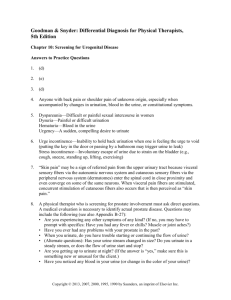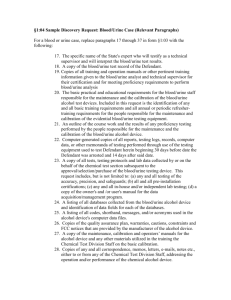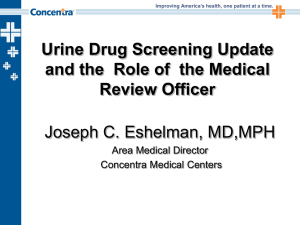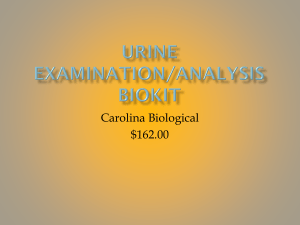word document
advertisement
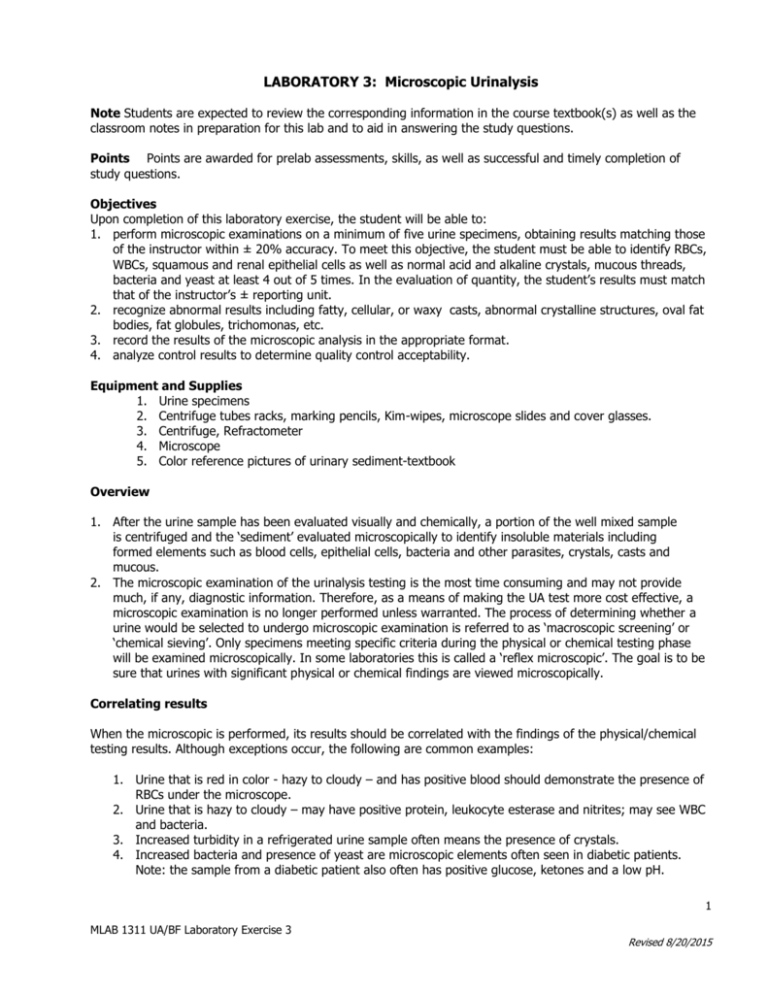
LABORATORY 3: Microscopic Urinalysis Note Students are expected to review the corresponding information in the course textbook(s) as well as the classroom notes in preparation for this lab and to aid in answering the study questions. Points Points are awarded for prelab assessments, skills, as well as successful and timely completion of study questions. Objectives Upon completion of this laboratory exercise, the student will be able to: 1. perform microscopic examinations on a minimum of five urine specimens, obtaining results matching those of the instructor within ± 20% accuracy. To meet this objective, the student must be able to identify RBCs, WBCs, squamous and renal epithelial cells as well as normal acid and alkaline crystals, mucous threads, bacteria and yeast at least 4 out of 5 times. In the evaluation of quantity, the student’s results must match that of the instructor’s ± reporting unit. 2. recognize abnormal results including fatty, cellular, or waxy casts, abnormal crystalline structures, oval fat bodies, fat globules, trichomonas, etc. 3. record the results of the microscopic analysis in the appropriate format. 4. analyze control results to determine quality control acceptability. Equipment and Supplies 1. Urine specimens 2. Centrifuge tubes racks, marking pencils, Kim-wipes, microscope slides and cover glasses. 3. Centrifuge, Refractometer 4. Microscope 5. Color reference pictures of urinary sediment-textbook Overview 1. After the urine sample has been evaluated visually and chemically, a portion of the well mixed sample is centrifuged and the ‘sediment’ evaluated microscopically to identify insoluble materials including formed elements such as blood cells, epithelial cells, bacteria and other parasites, crystals, casts and mucous. 2. The microscopic examination of the urinalysis testing is the most time consuming and may not provide much, if any, diagnostic information. Therefore, as a means of making the UA test more cost effective, a microscopic examination is no longer performed unless warranted. The process of determining whether a urine would be selected to undergo microscopic examination is referred to as ‘macroscopic screening’ or ‘chemical sieving’. Only specimens meeting specific criteria during the physical or chemical testing phase will be examined microscopically. In some laboratories this is called a ‘reflex microscopic’. The goal is to be sure that urines with significant physical or chemical findings are viewed microscopically. Correlating results When the microscopic is performed, its results should be correlated with the findings of the physical/chemical testing results. Although exceptions occur, the following are common examples: 1. Urine that is red in color - hazy to cloudy – and has positive blood should demonstrate the presence of RBCs under the microscope. 2. Urine that is hazy to cloudy – may have positive protein, leukocyte esterase and nitrites; may see WBC and bacteria. 3. Increased turbidity in a refrigerated urine sample often means the presence of crystals. 4. Increased bacteria and presence of yeast are microscopic elements often seen in diabetic patients. Note: the sample from a diabetic patient also often has positive glucose, ketones and a low pH. 1 MLAB 1311 UA/BF Laboratory Exercise 3 Revised 8/20/2015 There are many possible reasons that a specimen’s physical and chemical characteristics do not correlate with the microscopic results. Among the first thing to be considered is a mix-up in samples - where the microscopic was not performed on the same sample as the physical and/or chemical analysis. Another possibility to consider is deterioration in the sample. This is most commonly seen when there is a significant lag period between the different phases of testing or if the sample is very alkaline. Regardless of the reason, the best course of action is to recollect the sample and repeat the testing ASAP. Remember, correlating results of the physical, chemical and microscopic examination of the urine is an important part of UA quality control. More information on correlation of physical/chemical results with expected microscopic analysis can be found in your textbook and other resources. Principles & Related Information The formed elements suspended in the urine are concentrated by centrifugation and analyzed under the microscope. Careful interpretation of the findings observed in examination of the urine sediment can provide rather accurate localizing information of pathologic processes in the urinary tract, or on occasion, point to a specific diagnosis of clinical problem. Normal urine sediment contains a limited number of formed elements including: 1-2 RBC Few WBC Few epithelial cells (squamous epithelial cells are most frequently identified, especially in females, they originate from the linings of the genitourinary system) Occasional hyaline cast In performing a microscopic examination of the urine, at least 10-15 fields of vision should be examined and averaged to enumerate each cellular element. This method is only a semi-quantitative method, but generally provides enough information to satisfy diagnostic needs. Urine Stains Some laboratories routinely use one or more stains to enhance visualization of the urine sediment. The most commonly used urine sediment stains are commercial preparations of a supravital stain developed by R. Sternheimer & B. Malbin. The basic ingredients of the Sternheimer - Malbin stain are crystal violet and safranin O in ethyl alcohol. Commercially prepared variations of this stain have added stabilizers to limit precipitation. KOVA Stain and Sedi-Stain are two such examples. Review the Urine Microscopic Examination PowerPoint and textbook for information on additional stains used when examining urine sediment. PROCEDURE Preparation of Slide for Microscopic Examination *1. Mix urine specimen thoroughly. *2. Pour approximately 10 ml of the urine into a urine centrifuge tube. *3. Centrifuge for at least 5 minutes at 1500-2000 RPM (low speed). Note: make sure the centrifuge is properly balanced. 4. Under the direction of the instructor, decant the urine supernatant. 5. Resuspend the sediment by one of the methods demonstrated by the instructor. 6. Using a pipette, place a small drop of sediment onto a clean glass microscope slide and coverslip - being careful to avoid creating bubbles. OR, if directed by your instructor, load a urine microscopic cartridge, such as a ‘Kova’ or a ‘Count 10’ slide. *You will only need to do these steps on your own specimen (SPECIMEN # 5); as they have been performed for you on the other specimens. 2 MLAB 1311 UA/BF Laboratory Exercise 3 Revised 8/20/2015 Examination 1. Position the slide on the mechanical stage of the microscope. 2. Use the low power objective to get the field into focus. 3. Scan the slide under low power to get an “overall impression.” Then observe 10-15 low power fields, including the coverslip edges and center. Check for casts and mucous threads. 4. Using high power, check another 10-15 fields for epithelial cells, red and white blood cells, crystals, sperm, bacteria, yeast and parasites. Check with available pictures and diagrams to aid in identification. 5. Use the “Urinalysis Reporting Standardization Guide” to aid in quantitation and reporting of urine microscopic sediment. Record all results in appropriate place, using appropriate format for recording patient and performance control results on the report form provided. Result forms not using appropriate format will have a 50% penalty. ✳ Recording of any laboratory result MUST be in black or blue ink. ✳ Acceptable recording for positive results: Positive or Pos ✳ Acceptable recording for negative results: Negative or Neg ✳ Other results are to be as indicated on the standardization guide. RECORDING RESULTS Record all results in appropriate place. Use appropriate format for recording patient results on the report form provided. Result forms not using appropriate format will have a penalty and may be completely rejected! Recording of any laboratory result MUST be in black or blue ink. All results must follow the format of the “Urinalysis Reporting Standardization Guide” provided. 3 MLAB 1311 UA/BF Laboratory Exercise 3 Revised 8/20/2015 EXAMPLE SAMPLE Specimen Patient Name Patient ID # Low power magnification (lpf) High power magnification (hpf) 1 Jones, Jim 12345 Casts *must identify type as well as quantify Mucous Occ hyaline 3-5 granular Squamous Epithelial cells Other Epithelial cells *must identify type as well as quantify WBCs RBCs Crystals *must identify type as well as quantify 0-2 Bacteria Yeast Trichomonas Other *must identify type as well as quantify Trace None seen None seen 1+ Occ transitional Rare renal 6-10 0-2 1+ amorphous urates Occ uric acid Occ CaOx Testing performed by: Date: Instructor, MT(ASCP) August 10, 2015 4 MLAB 1311 UA/BF Laboratory Exercise 3 Revised 8/20/2015 Urinalysis Reporting Standardization Guide (rev 8/19/15) Use & Purpose Use this form to guide as you evaluate urine in the MLAB laboratory. When at clinical rotations, be sure to consult with your mentor on that facility’s reporting criteria. The purpose of this guide is to standardize the way urinalysis results are to be reported in our labs. Urine Colors Use only the following terms: colorless, light yellow, yellow, dark yellow, amber, orange, red, brown, black, blue, or green. Consult with your lab instructor if you encounter an unusual color. Appearance/Clarity Note: clarity is different from color. Clarity is an evaluation of how light passes through the urine sample. It provides an indication of the amount (and possibly the type) of sediment you should expect to see under the microscope. Use the following terms to describe appearance/clarity: clear, slightly hazy, hazy, slightly cloudy, cloudy, and turbid (a thick obvious sediment that settles to the bottom of the cup upon standing). Quantifying Microscopic Elements Use the following table as you quantify the urine sample’s sediment. Directions: 1. Find the name of the element in the far left column. 2. Note whether the element is counted using low power (10X/lpf) or high power (40X/hpf). 3. Use the block of information under the “Enumerated As” to report the urine sediment. Casts require special consideration; they are counted using 10X, but you may have to go to 40X to identify them. Examples: 1. Evaluating WBCs - using high power/40X; looking at 5-10 distinct high power fields, you see 7 in one field, 5 in another, 9 in the third, etc. - you would report: 6-10 WBC/hpf. 2. A red colored sample with positive blood having more than 200 RBC/hpf would be reported as > 200/hpf. Note: A quick way of determining whether there are more than 200 RBC/field is to mentally divide the visual field into quarters - count only what is in one representative quarter - if it is at least 50, there are more than 200 cells. 3. *A refrigerated urine sample may develop amorphous urate crystals and obscure the field of view. The appropriate report is “many” amorphous urates. 5 MLAB 1311 UA/BF Laboratory Exercise 3 Revised 8/20/2015 Urinalysis Reporting Standardization Guide Different laboratories may use different criteria / terminology when reporting urine sediment. We have chosen to use this system to standardize reporting in our MLT labs. When at a clinical site, you must adopt and use the reporting system of that site. Element Casts* Epithelial Cells Counted on lpf ✔ Enumerated As hpf ✔ Occ Occ 0-2 0-2 3-5 3-5 6-10 6-10 11-20 11-20 21-50 21-50 51-100 51-100 100-200 100-200 > 200 > 200 WBC RBC ✔ ✔ Occ Occ 0-2 0-2 3-5 3-5 6-10 6-10 11-20 11-20 21-50 21-50 51-100 51-100 100-200 100-200 > 200 > 200 Crystals-Formed ✔ 0-2 Crystals-Amorphous ✔ 3-5 6-10 Slight Mod** Many ✔ Slight Few Mod Mod Yeast ✔ Few Mod Many TNTC * Many Sperm Trichomonas ✔ ✔ Mucous Bacteria ✔ 11-20 21-50 >50 ** Note: When reporting urine Crystals, you must identify the type of crystal, as well as quantify it. See text or other references for descriptions of acid, alkaline and pathologic crystals. Record as “present” Record as “present” * Casts are counted on low power magnification; however, it is common practice to switch to the high power objective to view/identify any internal structures. *TNTC = Too many too count **Mod = Moderate 6 MLAB 1311 UA/BF Laboratory Exercise 3 Revised 8/20/2015 Specimen Patient Name Patient ID # Low power magnification (lpf) High power magnification (hpf) 1 Student Name __________________________ Date _________________ XYZ Medical Clinic 2243 Medical Parkway Austin, Texas 78701 2 3 4 ____ / 25 points 5 Casts *must identify type as well as quantify Mucous Squamous Epithelial cells Other Epithelial cells *must identify type as well as quantify WBCs RBCs Crystals *must identify type as well as quantify Bacteria Yeast Trichomonas Other *must identify type as well as quantify Testing performed by: Date: 7 MLAB 1311 UA/BF Laboratory Exercise 3 Revised 8/20/2015 Laboratory Exercise #3: Study Questions Student Name ______________________ Date _____________________ ___ / 21 points Instructions: Answer the following questions using lecture notes, reading assignments, and information presented in the laboratory. Each question is worth one point unless otherwise stated. 1. What is the primary reason of performing ‘macroscopic screening’ on urine specimens? A. Increases cost effectiveness of the procedure / allow staff to spend time on specimens with more pathological structures. B. Provide the results to the physician quicker. C. To better predict the types of casts and other structures in the sample. D. To decrease the need for polarized microscopy. 2. (15 total pts) Complete the following chart. 1 /2 point each Microscopic structure High or Low power? According to information presented in this lab, indicate what level of magnification is to be used to quantify these structures. 2 points each Describe the structure’s microscopic appearance. RBCs WBCs Squamous Epithelial cells Renal Epithelial cells Oval Fat Bodies Hyaline Casts Question totals ___/3 pts ____/ 12 3. List two structures that are frequently confused with RBCs? 4. What type of epithelial cell is most frequently seen in a random urine specimen and from where do they originate? 5. What microscopic structure(s) would you expect to see in a specimen that has a positive nitrite? 6. What microscopic structure(s) would you expect to find in a specimen collected from a known diabetic with positive urine glucose? 7. What reagents are used in the Sternheimer-Malbin stain? 8 MLAB 1311 UA/BF Laboratory Exercise 3 Revised 8/20/2015

